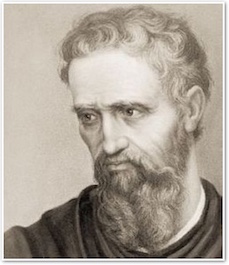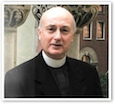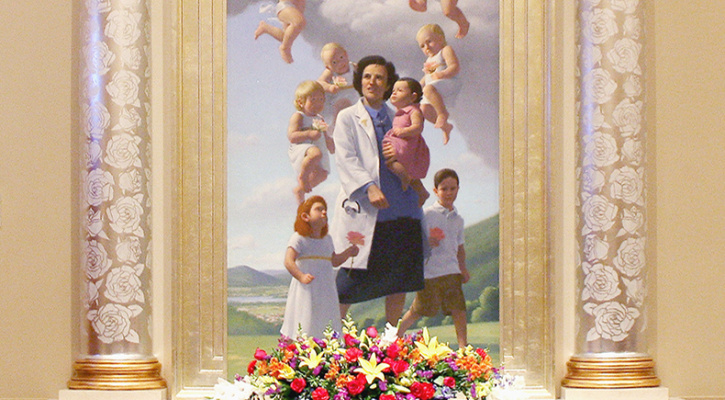It is finished!

Msgr. Charles Pope: In an Age of Moral Confusion, We Must Be Clear About the True Meaning of Conscience
February 14, 2018
SNAP Beneficiaries May Get More Food in a Box, Less Cash on a Card
February 14, 2018
Painting: Michelangelo Buonarroti 1475-1564
By Father George W. Rutler, From the Pastor, February 11, 2018
Artists rarely think that they have completed a work.
There are different theories as to why Schubert did not finish the Unfinished Symphony. Although his Symphony in B minor lacks two movements, it has two. And explaining why it began is as challenging as explaining why it did not end. Mozart did not finish his Requiem for the simple reason that he died. That also is why Thucydides did not finish his History of the Peloponnesian War, Raphael’s Transfiguration was incomplete, Giorgione’s Sleeping Venus was left for Titian to complete, and Dostoyevsky’s The Brothers Karamazov had unrealized chapters.
A Roman soldier’s sword prevented Archimedes from resolving a mathematical problem. Chaucer did not finish his Canterbury Tales because he had to go back to work as a clerk in the Port of London, and Spenser did not finish the last six books of The Faerie Queene for political reasons. Coleridge could not complete his Kubla Khan because someone awoke him from a laudanum stupor. Perhaps the arrival of Alessandro de’ Medici caused Michelangelo to quit Florence without finishing the statue that still puzzles experts, who are not sure if it is Apollo or David. We do know that Donatello deliberately used his non finito technique to give a kind of emerging vitality to his figures.
Artists rarely think that they have completed a work. Tolkien, for example, kept re-writing The Silmarillion. At least they have an intuition, a mental sense, of what should be realized with paint or pen. But if life has no goal, there is nothing to complete. Chesterton said that man has always been lost, but modern man has lost his address and cannot return home. Far different was Saint Paul: “I have fought the good fight, I have finished the race, I have kept the faith” (2 Timothy 4:7). His faith was trust that life has a goal, and it is realized in the eternal existence offered by the Creator who made us in his image. “In him you have been made complete” (Colossians 2:10).
The days of Lent are like signposts toward the goal. Meanwhile, we are “works in progress.” The question is, “Can these bones live?” (Ezekiel 37:3). When Ash Wednesday is coincident with St. Valentine’s Day, there is a stark contrast between love and sentiment. The martyr Valentine loved so much that he sacrificed his life for the love of God. To reduce him to some sort of cupid, is never to finish the picture.
The world’s greatest Lover shouted from the cross: “It is finished!” That tetelestai is an accounting term meaning “paid in full.” The Son cried out to the Father that he had paid the debt incurred by human pride. It is what every composer, painter, writer or scientist wants to be able to say, but can only be said satisfactorily when Christ is seen “face to face, and not as a stranger” (1 John 3:2).
Acknowledgement
 Father George W. Rutler. “It is finished!” From the Pastor (February 11, 2018).
Father George W. Rutler. “It is finished!” From the Pastor (February 11, 2018).
Reprinted with permission from Father George W. Rutler.
The Author

 Father George W. Rutler is the pastor of St. Michael’s church in New York City. He has written many books, including: The Stories of Hymns, Hints of Heaven: The Parables of Christ and What They Mean for You, Principalities and Powers: Spiritual Combat 1942-1943, Cloud of Witnesses — Dead People I Knew When They Were Alive, Coincidentally: Unserious Reflections on Trivial Connections, A Crisis of Saints: Essays on People and Principles, Brightest and Best, Saint John Vianney: The Cure D’Ars Today, Crisis in Culture,and Adam Danced: The Cross and the Seven Deadly Sins.
Father George W. Rutler is the pastor of St. Michael’s church in New York City. He has written many books, including: The Stories of Hymns, Hints of Heaven: The Parables of Christ and What They Mean for You, Principalities and Powers: Spiritual Combat 1942-1943, Cloud of Witnesses — Dead People I Knew When They Were Alive, Coincidentally: Unserious Reflections on Trivial Connections, A Crisis of Saints: Essays on People and Principles, Brightest and Best, Saint John Vianney: The Cure D’Ars Today, Crisis in Culture,and Adam Danced: The Cross and the Seven Deadly Sins.
Copyright © 2018 Father George W. Rutler
Catholic Education Resource Center
https://www.catholiceducation.org/en/religion-and-philosophy/other-topics/it-is-finished.html





